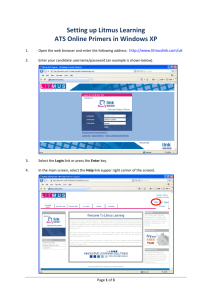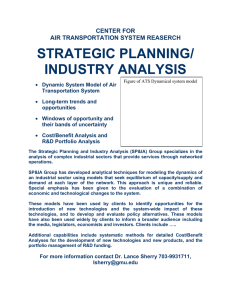SEMI-AUTOMATIC EXTRACTION OF RIBBON ROADS FORM HIGH RESOLUTION
advertisement
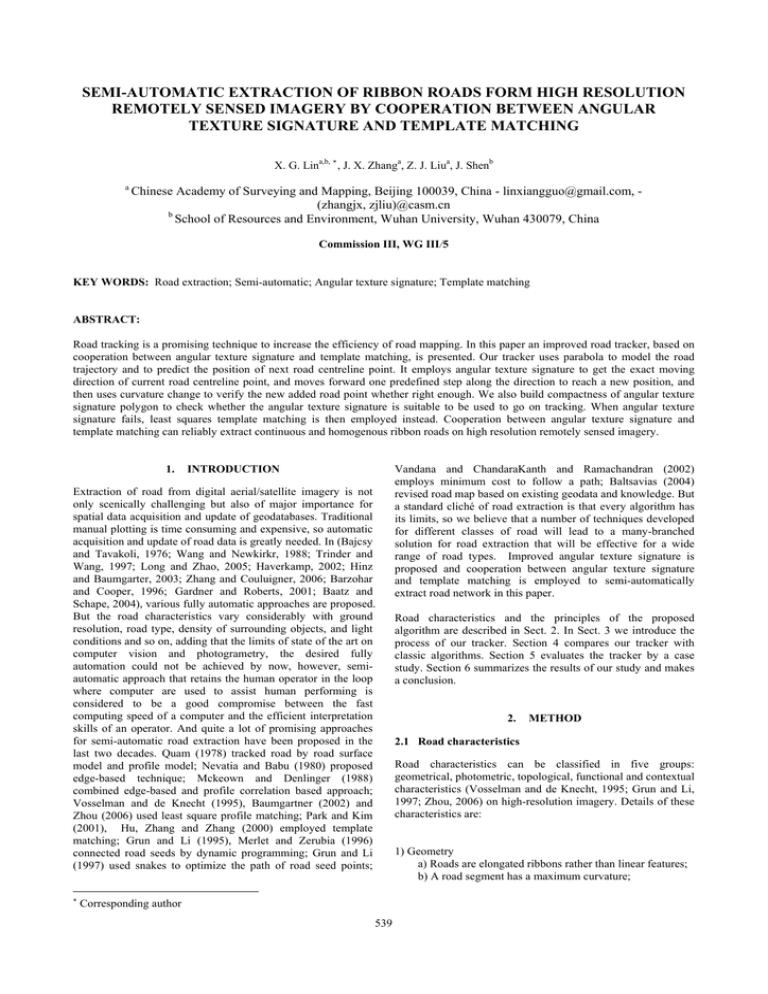
SEMI-AUTOMATIC EXTRACTION OF RIBBON ROADS FORM HIGH RESOLUTION
REMOTELY SENSED IMAGERY BY COOPERATION BETWEEN ANGULAR
TEXTURE SIGNATURE AND TEMPLATE MATCHING
X. G. Lina,b, ∗ , J. X. Zhanga, Z. J. Liua, J. Shenb
a
Chinese Academy of Surveying and Mapping, Beijing 100039, China - linxiangguo@gmail.com, (zhangjx, zjliu)@casm.cn
b
School of Resources and Environment, Wuhan University, Wuhan 430079, China
Commission III, WG III/5
KEY WORDS: Road extraction; Semi-automatic; Angular texture signature; Template matching
ABSTRACT:
Road tracking is a promising technique to increase the efficiency of road mapping. In this paper an improved road tracker, based on
cooperation between angular texture signature and template matching, is presented. Our tracker uses parabola to model the road
trajectory and to predict the position of next road centreline point. It employs angular texture signature to get the exact moving
direction of current road centreline point, and moves forward one predefined step along the direction to reach a new position, and
then uses curvature change to verify the new added road point whether right enough. We also build compactness of angular texture
signature polygon to check whether the angular texture signature is suitable to be used to go on tracking. When angular texture
signature fails, least squares template matching is then employed instead. Cooperation between angular texture signature and
template matching can reliably extract continuous and homogenous ribbon roads on high resolution remotely sensed imagery.
1.
INTRODUCTION
Extraction of road from digital aerial/satellite imagery is not
only scenically challenging but also of major importance for
spatial data acquisition and update of geodatabases. Traditional
manual plotting is time consuming and expensive, so automatic
acquisition and update of road data is greatly needed. In (Bajcsy
and Tavakoli, 1976; Wang and Newkirkr, 1988; Trinder and
Wang, 1997; Long and Zhao, 2005; Haverkamp, 2002; Hinz
and Baumgarter, 2003; Zhang and Couluigner, 2006; Barzohar
and Cooper, 1996; Gardner and Roberts, 2001; Baatz and
Schape, 2004), various fully automatic approaches are proposed.
But the road characteristics vary considerably with ground
resolution, road type, density of surrounding objects, and light
conditions and so on, adding that the limits of state of the art on
computer vision and photogrametry, the desired fully
automation could not be achieved by now, however, semiautomatic approach that retains the human operator in the loop
where computer are used to assist human performing is
considered to be a good compromise between the fast
computing speed of a computer and the efficient interpretation
skills of an operator. And quite a lot of promising approaches
for semi-automatic road extraction have been proposed in the
last two decades. Quam (1978) tracked road by road surface
model and profile model; Nevatia and Babu (1980) proposed
edge-based technique; Mckeown and Denlinger (1988)
combined edge-based and profile correlation based approach;
Vosselman and de Knecht (1995), Baumgartner (2002) and
Zhou (2006) used least square profile matching; Park and Kim
(2001), Hu, Zhang and Zhang (2000) employed template
matching; Grun and Li (1995), Merlet and Zerubia (1996)
connected road seeds by dynamic programming; Grun and Li
(1997) used snakes to optimize the path of road seed points;
∗
Corresponding author
539
Vandana and ChandaraKanth and Ramachandran (2002)
employs minimum cost to follow a path; Baltsavias (2004)
revised road map based on existing geodata and knowledge. But
a standard cliché of road extraction is that every algorithm has
its limits, so we believe that a number of techniques developed
for different classes of road will lead to a many-branched
solution for road extraction that will be effective for a wide
range of road types. Improved angular texture signature is
proposed and cooperation between angular texture signature
and template matching is employed to semi-automatically
extract road network in this paper.
Road characteristics and the principles of the proposed
algorithm are described in Sect. 2. In Sect. 3 we introduce the
process of our tracker. Section 4 compares our tracker with
classic algorithms. Section 5 evaluates the tracker by a case
study. Section 6 summarizes the results of our study and makes
a conclusion.
2.
METHOD
2.1 Road characteristics
Road characteristics can be classified in five groups:
geometrical, photometric, topological, functional and contextual
characteristics (Vosselman and de Knecht, 1995; Grun and Li,
1997; Zhou, 2006) on high-resolution imagery. Details of these
characteristics are:
1) Geometry
a) Roads are elongated ribbons rather than linear features;
b) A road segment has a maximum curvature;
The International Archives of the Photogrammetry, Remote Sensing and Spatial Information Sciences. Vol. XXXVII. Part B3b. Beijing 2008
The parabola in the x ⊥ y plane can have arbitrary
orientation, having an equation of the form:
c) A road segment has a constant width.
2) Radiometry
d) The road surface usually is smooth and homogeneous;
e) The road has a good contrast with its adjacent areas.
3) Topology
Ax 2 + Bxy + Cy 2 + Dx + Ey + F = 0
where x and y are coordinates of point on the
A, B, C, D, E, F are parameters.
f) The road will continue and do not stop without a
reason;
g) The roads intersect and form a network.
4) Function
h) The roads connect human settlements.
5) Context
i) Overpasses, higher roads, adjacent buildings and tress
may cast a shadow;
j) Roads may be occluded by vehicles and other obstacles.
18
17
16
36
15
1
14
2
8
a
60
50
b
34
31
28
25
22
19
16
13
10
7
40
4
Direction Index
180
160
140
120
100
c
80
34
31
28
25
22
19
16
13
10
60
7
10, 20, 29). At each pixel p , the number k and location of the
strong local limits are computed from the ATS. For example,
the signature shown in Fig. 1(a) has 4 limits that are significant.
We refer to the number k of limit as the degree of the pixel.
The texture measures that are used in road detection are: the
degree of the pixel and the direction of the limit. In our
approach, on the assumption that the roads have the above a), b),
c), d), e) properties, a rectangular template is extended from and
rotated 180 deg from the perpendicular of the potential road
direction about each road pixel. At discrete intervals about the
pixel, the ATS is calculated; and the direction of the limit is
regarded as the road direction. If the ATS takes the variance or
entropy as measure, the direction of local minimum is taken;
while if the ATS takes the mean as measure, the direction of
local minimum is takes for bright roads and the direction of
local maximum is taken for darker road as shown in Fig. 2.
Once the road direction is given, move on one step along the
direction and iterate the above process until the tracker fails or
reaches to another tracked road trajectory or reaches to the
boundary of the image.
7
12
9 10
70
4
The graph and values of an ATS for a single point p are
shown in Fig. 1. The local limits on this graph correspond to the
most likely directions of the road at point p (e.g. directions 3,
6
80
1
values
{T (α 0 , w, h, p), T (α 1 , w, h, p),…,T (α n , w, h, p)} .
1
of
11
5
Angular Standard deviation
set
4
Angular Mean
the
13
3
90
as
20
34
p .At the point p , the
defined
21
19
100
is
22
33
grey image, angular texture signature (ATS) T (α , w, h, p ) is
defined as the mean, standard deviation, variance or entropy for
a rectangular set of pixels of width w and height h around the
potential road pixel p whose principal axis lies at an angle of
α from the potential road direction. This measure is computed
ATS
23
35
A texture measure is described in (Haverkamp, 2002) and
defined and extended by us as follows. At each pixel p of a
at pixel
24
32
2.2 Principles of angular texture signature
α 0 ,…, α n
25
26
31
The operator use the above characters and prior knowledge to
detect and identify a road segment, and the proposed tracker
works based on a), b), c), d), e) properties
for a set of angles
27
28
29
30
(1)
parabola,
Direction Index
2.3 Road trajectory model
Fig.1 Angular texture signature (a) The effect of rotating
templates in 36 discrete angles (the rectangles whose indexes
are odd is invisible for convenience) (b) The standard
deviations of 36 templates (c) The means of 36 templates
Road trajectory can be modelled by B-splines ( Trinder and Li,
1997), straight line (Haverkamp, 2002), Kalman filter
(Vosselman and de Knecht, 1995), extended Kalman filter
(Zhou, 2006), particle filter (Zhou, 2006), and parabola
(Mckeown and Denlinger, 1988).
540
The International Archives of the Photogrammetry, Remote Sensing and Spatial Information Sciences. Vol. XXXVII. Part B3b. Beijing 2008
ATS for some interesting pixels with the ATS polygons shown
in red. If the road has a good contrast with its surrounding
objects, the polygon looks like an ellipse or ∞ -Shape. The
compactness of ATS is defined as the compactness of the ATS
polygon using Eq. (4). We must note that the ATS polygon in
our tracker is just half of the above illustrated polygon because
we just rotate the rectangular template 180 deg, and our ATS
polygon is form by plotting the ATS values around the pixel
under consideration with corresponding direction and link the
last point and the first point to the current pixel. The
compactness tells us whether the ATS polygon looks like a
circle. A circle-like ATS polygon usually means that the tracker
is no longer fit to be used to follow road centerline point, and it
needs manual plotting.
We don’t use this equation since the parametric form is more
convenient for our purpose. We represent the road path
parametrically as two separate functions x (l ) and y (l )
l is the total length in steps that we have traversed along
2
the road’s path. We use multiple regression with l and l as
the independent variables to fit parabolas to x (l ) and y (l ) ,
where
getting approximate functions:
X (l ) = a1l 2 + b1l + c1
(2)
Y (l ) = a 2 l 2 + b2 l + c 2
where
X (l )
x coordinates
and
and
Y(l)
are the road centreline points
y coordinates, a1 , b1 , c1 , a 2 , b2 ,c 2
ATS compactness =
are
the parameters.
2 | b1c2 − c1b2 |
2
[4(c1 + c2 ) l + 4(c1b1 + c2b2 )l + b1 + b2 ]3 / 2
2 2
2
(4)
where A and P are the area and perimeter of the ATS
polygon, respectively. Note that P doesn’t include the
distance between the first point and the current pixel and the
distance between the last point and the current pixel.
To get the most possible potential direction of the road, we
resort to compute X (l + 1) and Y(l +1) , that is the most
possible location of the next road centreline point.
Given that the road segment has a maximum curvature, then the
change of the curvature of two adjacent road points must be less
than a predefined threshold T . The curvature K at some point
on the parabola can be computed as follows:
K=
2 ⋅π ⋅ A
P2
2.5 Least square template matching
Our least squares template matching is as the same as Park and
Kim’ one (2001).
(3)
3.
THE PROCESS OF OUR TRACKER
Semi-automatic road extraction here is undertaken as follows.
where
a1 , b1 , c1 , a 2 , b2 ,c 2 are the same as in Eq. (2).
3.1 Pre-process the input image
If the original image doesn’t have a good contrast between road
and other features, it needs stretching. Then the image is
convolved with a Gaussian filter to smooth the image and
reduce the high-frequency noise.
a
G = exp( −
b
where
σ
=
2
x2 + y2
)
2σ 2
(5)
pixels.
3.2 The operator detects a road segment
A human operator has to identify a short part of a road axis; this
road part serves as initialization for an automatic tracker. The
tracker need a starting point on the road centreline and a second
point to define the direction of the road and a third
Fig.2 The wind rose chart of Angular Texture
Signature (a) The mean ATS of a darker road (b) The
mean ATS of a brighter road
point to define the width w of the road. Then the road tracker
move forward at least 5 steps along the initial direction, then the
road trajectory model can be built by Eq. (2). Predict the next
road position and get the most possible potential road direction.
2.4 Compactness of ATS
When we take a closer look at the ATS rotating a full 360 deg
of each pixel, we can find some interesting links between the
shape of the ATS polygon and corresponding pixel types. To
form the ATS polygon, instead of plotting the ATS values for
each direction along a horizontal line, we plot the ATS values
around the pixel under consideration with corresponding
direction and link the last point to the first point. The resulting
polygon is called the ATS polygon. Fig. 2 shows the calculated
3.3 Compute ATS
From the last road centreline point in the trajectory, a
rectangular template is formed with width w and height 2* w ,
and rotate 180 deg from the perpendicular of the predicted
direction. At discrete intervals about the pixel, the angular
541
The International Archives of the Photogrammetry, Remote Sensing and Spatial Information Sciences. Vol. XXXVII. Part B3b. Beijing 2008
finishes immediately after initialization. The snakes is slower
than profile matching. The template matching is slower than
snakes but faster than ATS. We can get the conclusion that our
proposed algorithm is more robust than other trackers.
texture signature is calculated. Selecting which texture
signature as the measure of ATS, it should judge by the road
conditions. After a lot of experiment, we conclude that, taking
variance, strand deviation or entropy as the measure of ATS if
the road has salient characteristic d) while taking mean as the
measure of ATS if the road has obvious characteristic e).
5.
3.4 Compute
ahead
Calculate the
ATS compactness
EXPERIAMENT AND EVALUATION
and move forward one step
a
ATS compactness by Eq. (4). If the value is larger
than predefined threshold T1 , it tells us that the ATS is not fit
any more to track road, and it needs least squares template
matching instead. Otherwise the direction of the limit is
regarded as the road direction, and moves the road trajectory
one step.
b
3.5 Compute the change of the curvature
Calculate the curvature of the new added road centreline by Eq.
(5), compare it with the curvature of last point, if the difference
is larger than predefined threshold T2 , delete the new point
from the road trajectory, and resort to manually plot. Otherwise,
predict the next road position by parabola equation and iterate
from 3.3 if the trajectory doesn’t reach to another trajectory or
the boundary of the image. Once the user accomplishes one
road segment or the tracker reaches to one tracked road or the
boundary of image, initializes another road segment and restart
from 3.2 again until all roads are tracked.
c
From the operator point of view, the procedure is as follows:
the operator has to initialize the tracker by three input points to
indicate the starting, the moving direction and the width of the
road segment, and then the tracker is triggered. Whenever the
internal evaluation of the tracking tool indicates that the tracker
might lost the road axis or be no longer fit, it demands for
interaction of the operator. Then the operator has to confirm the
tracker or the user must edit the extracted road and put the
tracker back on the road.
4.
d
COMPARISION OF FOUR TRACKERS
e
To verify our algorithm, we make a comparison between least
square template matching, least square profile matching, snakes
and our tracker on a same Quickbird image of Huai’rou County
in Beijing, China, whose size is 355 by 1066 pixels. On this
image, there is a brighter centreline on the homogenous darker
road surface with a brighter background. The results are shown
in Fig. 3. All trackers extract the road centreline with different
precision in red colour. For profile matching, the front part of
the path is quite good but the last part of the extracted road
trajectory has a larger deviation due to the larger curving of the
road. For template matching, the extracted road trajectory is
good but with some larger deviate points along the trajectory.
For snakes, if there is only two seed points on centreline, the
extracted road trajectory is quite wrong, as shown in Fig. 3(c),
the up line; but if there is 5 road seed points, the result are quite
good, as shown in Fig. 3(c), the down line. For ATS taking
variance as measure, there is some acceptable deviation in the
middle part of the road. For ATS taking mean as measure, the
extracted road trajectory is very good. We also record the time
needed by each tracker. Profile matching is so fast that it
Fig. 3 Comparison of algorithms (a)The result of profile
matching (b) The result of template matching (c) The result of
snakes (d) The result of angular texture signature tale standard
deviation as measure (e) The result of angular texture signature
take mean as measure
The algorithm proposed here was tested by one Quickbird
image over Hefei City, An’hui Province, China. The image with
2181 by 1998 pixels contains many different road types such as
straight roads, curves, and crossings at different orientations.
And for each segment, the surface material is same, but there is
sudden change in radiometry, as shown in Fig. 4. The roads
have different disturbing objects such as shadows of trees and
542
The International Archives of the Photogrammetry, Remote Sensing and Spatial Information Sciences. Vol. XXXVII. Part B3b. Beijing 2008
compactness coefficient to evaluate the aptness of itself to go
on tracking, so the algorithm has some ability of higher-level
reasoning. The current limitations are that the algorithm may
not work on the road cast by much shadow and occlusion in
complex scenes, it can’t judge the validity of input seeds, it can
only track long ribbon roads on grey scale imagery, and it need
more computing times. These limitations are currently being
examined now. The main contribution of this paper is that it
employs angular texture signature semi-automatically extract
road with precise results.
occlusions by vehicles, but the shadow and occlusion is not
serious. In the procedure of tracking, there are 8 times the
tracker deviating the path, and then the thread is ceased as soon
as possible by the operator. There are 6 times prompts notifying
the user that the tracker is no longer suitable and it needs
manual plotting. And there are only 76 manual input points, and
the whole process takes 543 seconds. But if the operator want
manually plot all path point with the same precision as the
tracker, it needs 1108 inputs and it takes 776 seconds. In
general, the quality of the result of manual and semi-automatic
plotting is equivalent, since the operator supervises the results
of the semi-automatic system and failures are edited online. On
average, the geometric accuracy is comparable, too. We also
test our tracker on many other grey scale images with different
resolution varied from 0.2 to 2.5 m, and the results are similar
in manual input saving about 90% and time saving about 30%.
REFERENCES
Bajcsy, R., Tavakoli, M., 1976. Computer recognition of roads
from satellite pictures. IEEE Transactions on Systerms, Man,
and Cybernetics, 6(9), pp. 623-627.
The result shows that our tracker is quite robust when the
photometric property of same road segment changes suddenly,
and when the tracker reaches to the junctions and it will go on
without stop. And the tracker can detect the road centreline of
the roads in any orientation with moderate curvature accurately,
and also works successfully for roads have some obstacles
caused by shadow and occlusion.
Baltsavias, E. P., 2004. Object extraction and revision by image
analysis using existing geodata and knowledge: current status
and steps towards operational systems .ISPRS Journal of
Photogrammetry & Remote Sensing, 58, pp. 131-151.
Barzohar, M., Cooper, D. B., 1996. Automatic finding main
roads in aerial images by using geometric-stochastic models
and estimation. IEEE Transactions on Pattern Analysis and
Machine Intelligence, 18(7), pp. 707-720.
Baumgartner, A., Hinz, S., Wiedemann, C., 2002. Efficient
methods and interfaces for road tracking. International Archives
of Photogrammetry and Remote Sensing, 34(3B), pp. 28–31.
Benz, U. C., Hofmann, P., Willhauck, G., et al., 2004. Multiresolution, object-oriented fuzzy analysis of remote sensing
data for GIS-ready information. ISPRS Journal of
Photogrammetry & Remote Sensing, 58, pp. 239– 258.
Doucette, P., Agouris, P., Stefanidis, A., 2004. Automated road
extraction from high resolution multi-spectral imagery.
Photogrammetric Engineering &Remote Sensing, 70(12), pp.
1405-1416.
Gardner, M. E., Robert, D. A., Funk, C., Noronha, V., 2001.
Road extraction from AVIRIS using spectral mixture and Q-tree
filter techniques. In: Proc. AVIRIS Airborne Geosciences
Workshop,
Pasadena,
California,
URL:ftp://popo.jpl.nasa.gov/pub/docs/workshops/01_docs/toc.h
tml (last accessed : April 20,2007).
Geman, D., Jedynak, B., 1996. An active testing model for
tracking roads in satellite images. IEEE Transaction on Pattern
Analysis and Machine Intelligence, 18(1), pp. 1-14.Gruen, A.,
1985. Adaptive least square correlation-A Powerful Image
Matching Technique. South African Journal of Photogrammetry,
Remote Sensing and Cartography, 14(3), pp. 175-187.
Fig. 4 Semi-automatic extracted road network on
Quickbird image (a) Overview (b) Local result.
Gruen, A., Li, H., 1995. Road extraction from aerial and
satellite images by dynamic programming. ISPRS Journal of
Photogrammetry and Remote Sensing, 50(4), pp. 11-20.
6. CONCLUSIONS
The proposed tracker based on ATS is very robust, because it
makes best use of the road characteristics on high-resolution
imagery. Our algorithm employ parabola equation to fit the
trajectory of the road and to predict the road position and
moving direction and to judge whether the new added road
point is right by check the curvature change, it also utilize
Gruen, A., Li, H., 1997. Semi-automatic linear feature
extraction by dynamic programming and LSB-Snakes.
Photogrammetic Engineering and Remote Sensing, 1997, 63(8),
pp. 985-995.
543
The International Archives of the Photogrammetry, Remote Sensing and Spatial Information Sciences. Vol. XXXVII. Part B3b. Beijing 2008
Shukla, V., Chandrakanth, R., Ramachandran, R., 2002. Semiautomatic road extraction algorithm for high resolution images
using path following approach.In:ICVGIP02, Ahmadabad, pp.
231-236.
Haverkamp, D., 2002. Extracting straight road structure in
urban environments using IKONOS satellite imagery. Optical
Engineering, 41(9), pp. 2107-2110.
Harvey, W., McGlone, J., MaKeown, D., Irvine, J., 2004. Usercentric evaluation of semi-automatic road network extraction.
Photogrammetric Engineering and Remote Sensing, 70(12), pp.
1353-1364.
Trinder, J. C., Li, H., 1997. Semi-automatic feature extraction
by snakes. In: Automatic Extraction of Man-made Objects from
Aerial and Space Images (2). Basel, Zürich,, pp. 245-255.
Trinder, J. C., Wang, Y. D, Sowm, Y. A., et al., 1997. Artificial
intelligence in 3D feature extraction. In: Automatic Extraction
of Man-made Objects from Aerial and Space Images (2), Basel,
Zürich, pp. 257-265.
Hinz, S., Baumgartner, A., 2003. Automatic extraction of urban
road network from multi-view aerial imagery. ISPRS Journal of
Photogrammetry & Remote Sensing, 58, pp. 83-98.
Hu, X., Zhang, Z., Zhang, J., 2000. An approach of semiautomated road extraction form aerial images based on template
matching and Neural Network. International Achieves of
Photogrammetry and Remote Sensing, Amsterdam, Netherlands,
Vol. XXXIII, Part B3, pp. 994-999.
Vosselman, G. and de Knecht, J., 1995. Road tracing by profile
matching and Kalman filtering. In Proceedings of the Workshop
on Automatic Extraction of Man-Made Objects from Aerial and
Space Images, pp. 265–274. Birkhaeuser, Germany.
Long, H., Zhao, Z., 2005. Urban road extraction from highresolution optical satellite image. International Journal of
Remote Sensing, 26(22), pp. 4907-4921.
Wang, F. G., Newkirkr, R., 1988. A knowledge-based system
for highway network extraction. IEEE Transaction on
Geoscience and Remote Sensing, 26(5), pp. 525-531.
Mckeown, D., Denlinger, J., 1988. Cooperative methods for
road tracing in aerial imagery. In: Proceedings of the IEEE
Conference in Computer Vision and Pattern Recognition, pp.
662–672. Ann Arbor, MI.
Zhang, Q., Couloigner, I., 2006. Benefit of the angular texture
signature for the separation of parking lots and roads on high
resolution multi-spectral imagery. Pattern Recognition Letters,
27, pp. 937-946.
Mena, J.B, 2003. State of the art on automatic road extraction
for GIS update : a novel classification. Pattern Recognition Letters, 24,pp. 3037- 3058.
Zhou, J., Bischof, W. F., Caelli, T., 2006. Road tracking in
aerial images based on human-computer interaction and
Baysian filtering. ISPRS Journal of Photogrammetry & Remote
Sensing, 61, pp. 108-124.
Merlet, N., Zerubia, J., 1996. New prospects in line detection by dynamic programming. IEEE Transaction on
Pattern Analysis and Machine Intelligence, 18(4), pp.
426-437.
ACKNOWLEDGEMENTS
Our research is funded by The National Key Basic Research
and Develop Program under Grant No. 20006CB701303.
Park, S., Kim, T., 2001. Semi-automatic road extraction
algorithm from IKONOS images using template matching. In:
Proc.22nd Asian Conference on Remote Sensing, Singapore, pp.
1209-1213.
Quam, L. H., 1978. Road tracking and anomaly detection in
aerial imagery. In: Image Understanding Workshop, London,
UK, pp. 51-55.
544
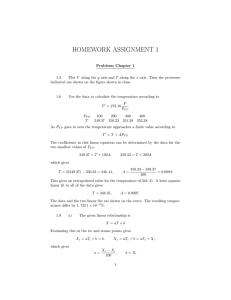
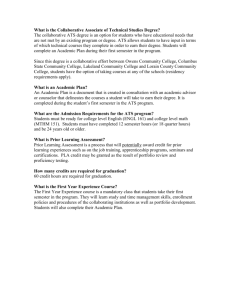
![June 2013 [DOCX 24.38KB]](http://s3.studylib.net/store/data/006990913_1-45414924984da7777020f5c1725fdda9-300x300.png)

